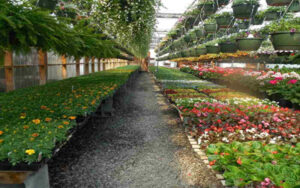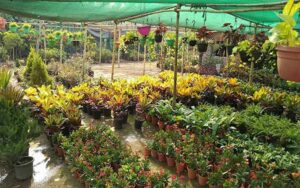Model nurseries – A classificatory exercise
Dr. Java Singh
Chief Learning officer,
Turn the Bus
In its early days, a plant nursery used to be just that, a place where gardening enthusiasts could pick up young plants. Before picking up the plant, they would have already arranged for farmyard manure, neem khali, bone meal, pots, trellis, jute strings, wires, secateurs, shovels, and a plethora of other inputs that go into the gardener’s cauldron. Over the years, though the old-style nursery that sells only plants maintains a robust presence, many nurseries have shifted from being kirana stores to supermarkets where gardeners can fulfill most of their requirements in a single visit.
The garden and nursery have always led an entangled life. Nurseries evolve and adapt to meet different garden types, that range from the meticulously curated arrangement of pots in a balcony to sprawling fruit gardens. Based on product type, the Tamil Nadu Agriculture University (TNAU) lists four classes of nurseries: fruit, vegetable, ornamental, and medicinal and aromatic. The product criterion should also include avenue and afforestation trees since this category has a significant presence in the nursery sector. In the TNAU classification, the product criterion is overlayed by type of sale, where again four kinds are listed, retail, wholesale, private, and mail-order. TNAU’s comprehensive classification based on sale and product types provides an ideal starting point for further analysis. The objective of pushing the line on classification is to enumerate a typology of distinct nursery models based on multi-dimensional criteria.
We know from the basic study of Biology that classification offers several advantages. Firstly, it facilitates identification, secondly; it helps to establish the relationship among various groups; thirdly, it helps to study the evolutionary history; and fourthly, by studying a few specimens, the characteristics of the whole group can be ascertained. In Biology, the advantages of identification, inter-relationships, evolutionary study, and generalization are narrated in the context of classification of living organisms into monera, potista, fungi, plantae, and animalia. However, the fundamental advantages are not restricted to organisms, instead they are pertinent to any attempt at classification. We will take up each advantage in the context of nursery categorization to understand its relevance.
Identification, especially self-identification provides operational clarity. It acts as guide to ordering priorities. For example, if we consider the TNAU classification where a nursery self-identifies as a retail, fruit plant nursery, it should align its supply chains and sale channels to match its identity. The reinforcement of its identity will enable easy recognition in the market, attracting the target consumer segment.
Inter-relationships with other nurseries will be determined by expected synergies. In the example under consideration, there would be upstream linkages with wholesale fruit plant nurseries and orchards for sapling stock. The retail nursery’s downstream linkages would include trade show and exhibition organizers where they could display their product for expanding their client base.
Evolutionary paths are determined by starting points and progressions. A retail fruit plant nursery may devolve into a wholesale nursery, or it may develop a multi-dimensional relationship with the customer. Instead of serving only as a point of sale, the retail set up could provide value-added services of upkeep and maintenance. It may also decide to enhance the consumer experience by offering in-season fruit picking and tasting tours.
Generalization is especially helpful for new entrants. When the experience of predecessors is compiled into sector studies, it becomes a valuable guidebook for aspiring nurseries. Even if no documented compilation is available, the incoming nursery can make inquiries in the market about the business practices of a few leading nurseries in the sector to become aware of generally established norms that must be kept in mind while planning the enterprise.
The advantages of classification are rendered superior when the classification criteria are drawn from fundamental characteristics of form and function of the subject at hand. If the criterion’s sweep is so large that it can include fundamentally different subjects, then the classificatory advantages stand diminished. For example, the criteria of type of sale can include any of the five product categories. Moreover, the single product segment criterion–fruit, vegetable, ornamental, medicinal-aromatic, and afforestation–excludes multi-product nurseries. The product-sale channel classifications do not provide a well-defined identification. Without a clear sense of identity, the enterprise is unable to avail of the subsequent advantages of inter-relationships, evolutionary paths, and generalized learnings.
Therefore, there is need to ideate on other criteria that would be conducive to a sharper understanding of business models. A fundamental characteristic would emerge from a fundamental resource. In the nursery business, land is a critical resource. Many a time, the decision to avail of the retail or wholesale channel depends on the extent of land available to the nursery. A nursery that is set up on a limited area is not suited to wholesale trade, it must operate at the retail level. The next fundamental resource, after land, is the product range that a nursery decides to stock. The selection of products is directly linked to variety of consumer segments that the nursery will have to handle. Both criteria are key to the market-oriented positions that the nursery will adopt. They are the basis for deciding the scope and the depth at which the nursery will operate, leading to two fundamental questions. First, will the nursery deal with a large number of customers? Second, will the nursery handle numerous classes of customers?
A classification based on land area and product selection leads to four models for nurseries, represented diagrammatically in a Selection-Area matrix as show in Figure 1.

A nursery that has limited land area and offers a curated selections from an extensive product range could benefit greatly by identifying itself as a boutique. A small or mid-sized nursery that stocks plants for ornamental, edible, landscaping, medicinal and aromatic purposes would be categorized as boutique. It would benefit greatly by learning about the general success criterion of boutique outfits, which include an immersive consumer experience and branding.
A nursery may choose to carry a limited selection to match its small land area. A small orchid nursery is a typical example of a ‘specialist’ nursery. The consumer would know beforehand about the limited range, therefore they may expect the specialist nursery to offer superlative quality. Well informed personnel who can discuss technical details with the prospective customer should be present at the premises. It should also stock technical literature on the selected products.
When a large extent of area is available to a nursery, it may choose to stock a limited or an extensive range of products. If the range is limited, then the nursery should function like a warehouse. The focus in the warehouse model is on cost competitiveness, efficient delivery, and optimum inventory. Should a large nursery decide to offer a large selection of products then it adopts an ‘Emporium’ model. Like an art and crafts emporium, the nursery would have clearly demarcated product sections that make it easy for the consumer to navigate. The attendants in the emporium must be informed to advise the consumer according to their specific requirements.
Clear evolutionary lines based on synergistic inter-relationships can be traced on the selection-area matrix. An emporium is essentially a scaled-up boutique therefore the two models share many common success factors. Similarly, a specialist can evolve into a warehouse without disruption of its identity and inter-relationships. Thus, horizontal evolutionary lines are a matter of change of scale.

On the other hand, vertical evolutionary lines imply a change in scope. Moving from model 1 to model 3 would involve rationalizing the product selection, and a reverse movement would necessitate enhancing the product range. Similar decisions would have to be made for large area nurseries that switch between models 2 and 4.
The articulation of nursery models is an attempt to facilitate nurseries to self-identify. The additional advantages that are expected from an unambiguous self-identification as one model or another will enable the nursery to locate synergistic inter-relationships, envisage evolutionary lines, and benefit from generalized learnings drawn from other nurseries in the same model class.
















